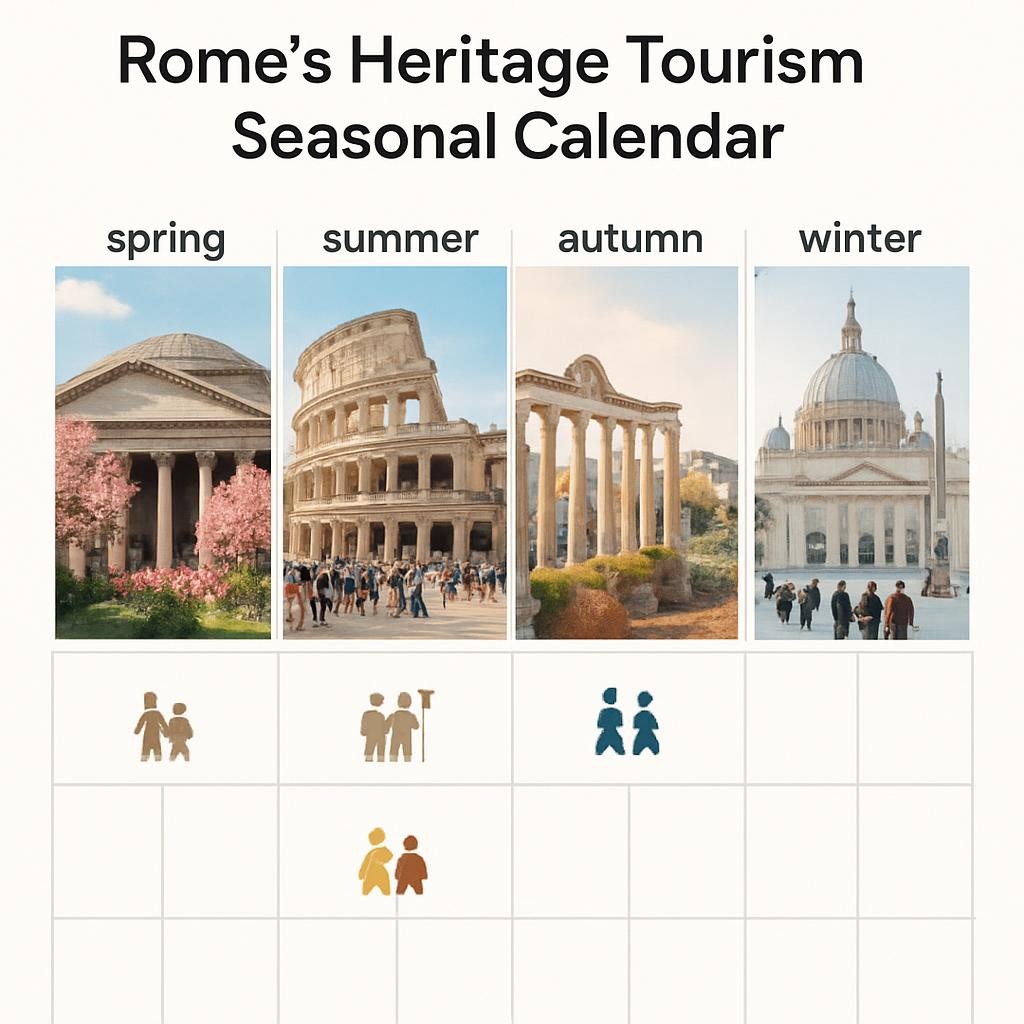How to Market Rome Historical Vacation Rentals Through Seasonal Cultural Events: A Heritage Tourism Guide

Introduction: The Eternal City's Seasonal Tourism Advantage
Rome stands as one of the world's premier destinations for heritage tourism, offering vacation rental owners unprecedented opportunities to capitalize on the city's rich historical narrative. With over 35 million pilgrims expected during the Rome Jubilee 2025, which runs from December 24, 2024, to January 6, 2026, property owners have a unique window to maximize their rental income through strategic seasonal marketing.
The key to success lies in understanding that Rome's tourism patterns extend far beyond traditional summer peaks. Cultural tourism in Rome operates on multiple seasonal cycles, from religious pilgrimages to educational tours, archaeological discoveries, and heritage festivals. Smart vacation rental owners recognize that each season brings distinct opportunities to attract different types of heritage-focused travelers.
Effective seasonal marketing for historical properties requires aligning your promotional strategy with Rome's cultural calendar, understanding educational tourism trends, and creating authentic experiences that connect guests with the city's 2,800-year history. By positioning your property as a gateway to Rome's historical treasures, you can achieve higher occupancy rates and premium pricing throughout the year.
Understanding Rome's Heritage Tourism Seasonal Patterns
Rome's heritage tourism follows distinct seasonal patterns that savvy vacation rental owners can leverage for optimal bookings. The traditional peak season runs from spring through October, with July and August experiencing the highest volumes due to family vacations and school breaks. However, historical properties have unique advantages during shoulder and off-seasons.

Winter heritage tourism presents exceptional opportunities, particularly during the upcoming Jubilee year. December through February sees increased religious tourism, with pilgrims seeking accommodations near major basilicas. Properties within walking distance of St. Peter's, St. John Lateran, St. Mary Major, or St. Paul Outside the Walls command premium rates during this period.
Educational tourism peaks during shoulder seasons when universities and cultural institutions organize study tours. Spring (March-May) and fall (September-November) attract history professors, archaeology students, and cultural tour groups seeking authentic accommodations in historically significant neighborhoods like Trastevere, Monti, or near the Roman Forum.
Understanding these patterns allows property owners to adjust pricing strategies, create targeted marketing campaigns, and develop partnerships with educational institutions. Properties that cater specifically to heritage tourists often achieve 15-20% higher average daily rates compared to generic accommodations, particularly when marketed to culturally motivated travelers seeking immersive historical experiences.
Leveraging the Rome Jubilee 2025 for Maximum Bookings
The Rome Jubilee 2025 represents the largest tourism opportunity in Rome for the next decade, with an estimated 35 million pilgrims expected to visit. This extraordinary event offers vacation rental owners a chance to significantly increase their revenue through strategic positioning and targeted marketing to religious and cultural tourism segments.
Key Jubilee dates create specific booking opportunities: the opening of Holy Doors at St. Peter's Basilica (December 24, 2024), St. John Lateran (December 29), St. Mary Major (January 1, 2025), and St. Paul Outside the Walls (January 5). Properties within proximity to these locations should implement premium pricing strategies and create special Jubilee packages that include guided tours, transportation, and cultural experiences.
Heritage tourism marketing during the Jubilee should emphasize authentic Roman experiences that connect guests with the city's spiritual and historical significance. Create partnerships with local guides specializing in papal history, early Christian Rome, and religious art. Offer curated experiences such as dawn visits to major basilicas, private tours of underground Christian sites, or cooking classes featuring traditional Vatican-area recipes.
Marketing materials should highlight your property's historical context within Rome's religious heritage. If your rental occupies a building with historical significance, research its connection to papal history, early Christian communities, or religious orders. This storytelling approach attracts culturally motivated travelers willing to pay premium rates for authentic heritage tourism experiences that generic hotels cannot provide.
Educational Tourism: Targeting History Enthusiasts Year-Round
Educational tourism represents a lucrative and consistent market segment for Rome's historical vacation rentals, with university groups, cultural institutions, and lifelong learners seeking authentic accommodations that enhance their learning experiences. This market operates year-round, with peak booking periods during academic shoulder seasons when formal educational tours are most common.

Target marketing should focus on universities with classics, archaeology, art history, and religious studies programs. Develop partnerships with study abroad coordinators, offering group rates and specialized amenities such as large common areas for seminars, high-speed internet for research, and proximity to major libraries and research institutions. Properties near the American Academy in Rome, Vatican Secret Archives, or major archaeological sites hold particular appeal for educational tourism segments.
Create detailed property descriptions that emphasize historical context and learning opportunities. Highlight nearby museums with free entry days, archaeological sites, and cultural institutions. Provide guests with curated reading lists, historical walking tour maps, and connections to local experts who can enhance their educational experience.
Heritage tourism enthusiasts appreciate properties that offer authentic cultural immersion. Consider amenities such as historical book libraries, reproductions of ancient Roman art, or partnerships with local artisans who can demonstrate traditional Roman crafts. These unique touches justify premium pricing while creating memorable experiences that generate positive reviews and repeat bookings from educational tour groups and individual history enthusiasts.
Cultural Event Marketing Calendar for Roman Properties
Successful seasonal marketing for Rome's historical vacation rentals requires a strategic approach to the city's rich cultural calendar. Beyond major events like the Jubilee, Rome hosts numerous heritage festivals, archaeological exhibitions, and cultural celebrations that create specific booking opportunities throughout the year.
Spring cultural events include the Rome Marathon (March), which attracts international visitors interested in combining athletic achievement with historical tourism. The Lungo Tevere festival (summer months) celebrates Roman river culture with traditional markets, food vendors, and historical reenactments along the Tiber. Properties near these events can implement surge pricing and create themed packages combining accommodation with event tickets and cultural experiences.
Heritage tourism reaches its peak during special archaeological events and museum exhibitions. The Colosseum offers free entry on specific dates, creating increased demand for nearby accommodations. Vatican Museums host special evening tours during certain periods, attracting culturally sophisticated travelers seeking exclusive experiences.
Develop a 12-month marketing calendar that aligns with Rome's cultural events, religious celebrations, and educational conferences. Create targeted social media campaigns, email marketing sequences, and partnership opportunities with event organizers. Properties that position themselves as cultural hubs rather than simple accommodations can achieve 25-30% higher booking rates during major cultural events while building long-term relationships with heritage tourism segments.
Creating Heritage Experience Packages That Sell
The most successful historical vacation rentals in Rome go beyond accommodation to offer comprehensive heritage tourism experiences that justify premium pricing and create unforgettable guest experiences. These packages combine lodging with curated cultural activities, expert guidance, and exclusive access to historical sites.
Develop partnerships with certified local guides specializing in Roman history, archaeology, and religious heritage. Create signature experiences such as "Underground Rome" tours featuring early Christian catacombs, "Imperial Rome" packages including private Colosseum access, or "Papal Rome" experiences with Vatican insider tours. These partnerships allow you to offer authentic cultural tourism experiences that generic accommodations cannot match.
Consider seasonal themes that align with Rome's cultural calendar. Spring packages might focus on archaeological discoveries and garden tours, while winter offerings could emphasize indoor cultural experiences like museum marathons and religious art exploration. Summer packages can include early morning site visits to avoid crowds, while fall offerings might feature harvest festivals and culinary heritage tours.
Educational tourism packages should include practical elements such as research support, library access, and connections with local academics. Offer "Scholar's Rome" packages featuring private study spaces, historical document reproductions, and meetings with archaeological experts. These specialized offerings attract high-value guests willing to pay premium rates for authentic learning experiences that enhance their Roman holiday.
Conclusion: Building Long-Term Success in Rome's Historical Market
Marketing historical vacation rentals in Rome requires a sophisticated understanding of heritage tourism patterns, cultural events, and educational travel trends. Success comes from positioning your property as more than accommodation – it should serve as a gateway to Rome's extraordinary historical narrative and cultural richness.
The upcoming Rome Jubilee 2025 presents an unprecedented opportunity for property owners willing to invest in targeted marketing, cultural partnerships, and authentic guest experiences. By aligning your marketing strategy with Rome's seasonal cultural calendar, developing relationships with educational institutions, and creating heritage-focused packages, you can achieve sustainable premium pricing and high occupancy rates.
Remember that cultural tourism travelers are typically more educated, affluent, and willing to pay higher rates for authentic experiences. They also tend to leave positive reviews, book longer stays, and return for future visits. By focusing on this market segment and continuously enhancing your property's historical authenticity and cultural offerings, you'll build a sustainable competitive advantage in Rome's dynamic vacation rental market.
